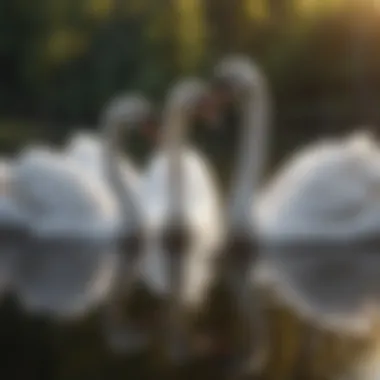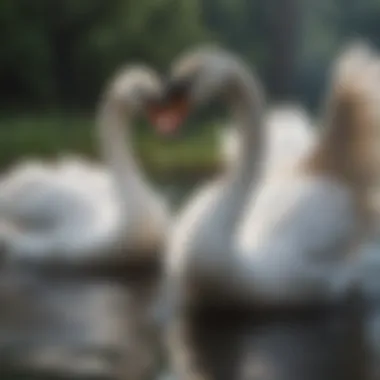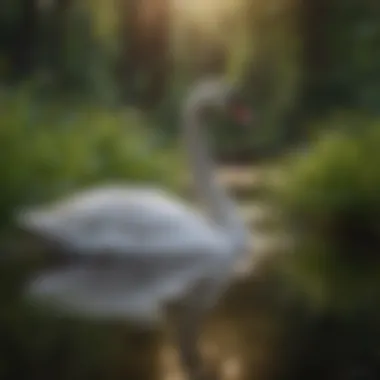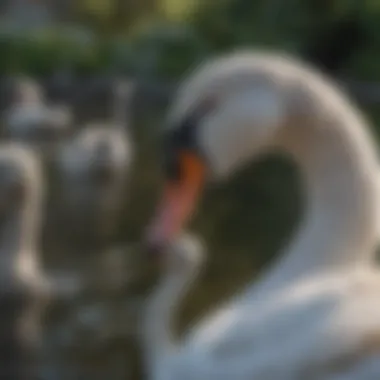The Essential Dietary Needs of Swans: Feeding Insights


Intro
Swans are captivating creatures that hold a special place in both natural ecosystems and human consciousness. Understanding the nutritional needs of swans is increasingly important. Their dietary habits reflect not only their health but also the overall health of their wetland habitats. In this article, we will explore various aspects of swan diets, including their food preferences, behavioral characteristics, and the effects of human activity on their natural feeding behaviors. With a focus on their ecological role and the impact of diet on health, this guide aims to provide a deeper understanding for veterinarians, wildlife biologists, and families interested in these elegant birds.
Fascinating Facts About the Animal
Swans are more than just beautiful animals; they possess unique features and behaviors that distinguish them in the avian world.
Unique Characteristics
Swans are the largest members of the waterfowl family. With long necks and large bodies, they exhibit graceful swimming abilities. Their feathers are typically white, but species like the Black Swan have striking dark plumage. This coloration helps them blend into their habitats, enhancing their ability to avoid predators.
Swans have a diverse diet that primarily consists of aquatic plants, insects, and small fish. Their long necks allow them to reach vegetation beneath the water’s surface. For instance, the Mute Swan is known for grazing on grass and submerged plants, while other species may focus more on invertebrates.
Extraordinary Abilities
One of the more fascinating abilities of swans is their instinctive migratory patterns. Many swan species travel long distances between breeding grounds and wintering locations. They are social creatures that often form monogamous pairs, which strengthens their bond, especially during migration.
In addition, swans communicate using a range of sounds, including trumpeting and hissing. These vocalizations serve to establish territory and maintain pair bonds. Such aspects of their behavior highlight the importance of social interactions and communication in swan communities.
Behavior and Habitat
Swans thrive in various environments, each offering a unique set of resources that cater to their nutritional needs.
Natural Habitats
Swans prefer habitats like lakes, rivers, marshes, and ponds rich in vegetation. Their choice of habitat significantly influences their diet. Aquatic vegetation such as pondweeds and water lilies is essential to their foraging behavior. They sometimes venture onto land for grazing in fields during warmer seasons, showcasing their adaptability.
Social Structures
Swans are known for their strong social structures. They form family units that can consist of a couple and their cygnets. These family groups often move and feed together, allowing young swans to learn important foraging techniques from their parents. Swans are also known to engage in cooperative behaviors, such as defending their territory against intruders collaboratively.
Recent Scientific Discoveries
Understanding the complexities of swan biology continues to evolve through ongoing research.
Latest Research Findings
Recent studies highlight the importance of diet composition for overall health. Research identifies a direct link between nutritional intake and reproductive success in swans. The intake of specific aquatic plants has been shown to influence the condition of both adults and cygnets, impacting their growth and survival rates.
Breakthroughs in Animal Biology
Scientific advancements in tracking technologies have allowed biologists to monitor swan movements and feeding patterns effectively. These breakthroughs have provided critical insights into how environmental changes affect food availability and subsequently, swan behaviors.
Cultural Significance
Swans have long held a prominent role in various cultures, symbolizing beauty and grace.
Animals in Folklore
In various mythologies, swans serve as symbols of transformation and fidelity. Folktales often emphasize their beauty and elegance, sometimes associating them with magical qualities. Many cultures revere swans, seeing them as creatures of spiritual significance.
Influence on Art and Literature
From classic literature to contemporary art, swans have inspired countless artists and writers. Their majestic appearance and graceful movements make them a popular subject in paintings, poetry, and music, encapsulating notions of purity and love. This cultural impact reinforces the need for conserving their habitats and protecting their populations.
The dietary habits of swans reflect not only their individual health but also the ecological balance of their environments. This interconnectedness underscores the importance of responsible human interaction with these magnificent birds.


Preamble to Swans
Swans are remarkable birds that play a significant role in aquatic ecosystems. Understanding their diet and feeding behaviors is crucial for their conservation and well-being. This section provides insights into the various species of swans and the cultural importance these elegant creatures hold in human societies.
Overview of Swan Species
Swans belong to the family Anatidae and are closely related to geese and ducks. There are several species of swans, with the most notable being the Mute Swan, Trumpeter Swan, and Whooper Swan. Each species has unique characteristics and adaptations that reflect their habitats. For example, the Mute Swan is commonly found in Europe and North America. It is recognizable by its orange bill and is often seen gliding gracefully on lakes and rivers. The Trumpeter Swan, primarily found in North America, is known for its loud trumpeting call and striking white plumage. Whooper Swans primarily inhabit Europe and Asia and are famous for their migratory behaviors.
Understanding these species helps identify their specific dietary needs and habitats. Each swan species has developed its own techniques for foraging, influenced by its environment and food availability. Recognizing these differences is important for studying their nutritional needs.
Cultural Significance of Swans
Swans have captivated humanity for centuries, symbolizing beauty, grace, and fidelity. In various cultures, they are often featured in folklore and art. For instance, in many Western traditions, swans are associated with romantic love and loyalty, primarily due to their monogamous nature. In literature, swans often appear as motifs representing transformation and purity.
Furthermore, swans hold ecological importance. They contribute to maintaining water quality and biodiversity in wetlands by feeding on aquatic vegetation and algae. Their presence indicates a healthy ecosystem, making their conservation increasingly vital.
In summary, swans signify much more than their physical beauty. They are integral to both natural ecosystems and cultural narratives, which emphasizes the need to understand their nutritional and ecological needs better. The subsequent sections will delve into the specifics of their natural diet, feeding behaviors, and the implications of human interaction.
Natural Diet of Swans
Understanding the natural diet of swans is essential. Knowing what swans consume helps in appreciating their roles in ecosystems. It also guides conservation efforts and informs the public about their dietary needs. Swans are primarily herbivorous, which means they mainly eat plant material. However, their diet can vary depending on their environment and seasonal changes.
Herbivorous Nature
Swans are classified as herbivores. This classification highlights their dependence on various forms of vegetation for sustenance. Their consumption of plant material is vital for their health and growth. The high nutrient content in plants supports their body functions, enabling reproduction and maintenance of energy levels. Understanding swans as herbivores emphasizes their ecological role, as they help manage aquatic plant growth and contribute to the overall health of their habitats.
Common Food Sources in Habitats
Aquatic Plants
Aquatic plants serve as a primary food source for swans. They thrive in freshwater habitats, providing both nutrition and shelter. These plants, such as pondweeds and water lilies, are rich in vitamins and minerals. Swans often feed on the leaves and stems, finding them easy to consume. One key characteristic of aquatic plants is their ability to grow in water, which makes them readily accessible to swans. The variety found in these plants contributes to a balanced diet, supporting skin and feather health.
Algae
Algae often go unnoticed but are significant in swan diets. They are abundant in many aquatic environments. Algae offer essential nutrients, including proteins and carbohydrates. Swans consume algae by filtering it from the water during feeding. The presence of algae contributes to a healthy and diverse diet. However, excessive algae growth can indicate pollution and lead to unhealthy water conditions, which can harm swan populations.
Vegetation Along Water Edges
Vegetation along water edges is another vital food source. This area holds diverse plants, such as grasses and shrubs. This vegetation is particularly important in providing a balanced diet, as swans can graze on plants available on land. A unique feature of this vegetation is its proximity to water, allowing swans to move easily between feeding on land and in the water. As a result, it enhances their foraging success. However, factors such as pollution or habitat destruction can reduce the availability of such food sources, potentially impacting swan health.
Seasonal Variations in Diet
Seasonal changes significantly impact the diet of swans. During spring and summer, swans have access to abundant vegetation, while in autumn and winter, the availability of food can decrease. This change in diet affects their health, behavior, and migratory patterns. Swans often adapt by altering their feeding strategies, seeking out new food sources as needed. Recognizing these variations is crucial for conservation efforts and understanding the challenges swans face in different seasons.
Feeding Behaviors
Feeding behaviors are vital to understanding the overall health and well-being of swans. The manner in which they feed impacts their nutritional intake, growth, and reproductive success. Recognizing these behaviors allows caregivers and wildlife enthusiasts to better support swans in both natural and controlled environments. It also unveils the relationship swans have with their habitats, showcasing how they interact with available food sources.
Dabbling and Grazing Techniques
Swans primarily exhibit two feeding techniques: dabbling and grazing. Both of these methods are essential for swan nutrition.
Dabbling refers to the technique where swans immerse their heads underwater while keeping their bodies afloat. This behavior enables them to access aquatic plants and small organisms that thrive in riverbeds and pond floors.
Commonly dabbling behaviors include:
- Filtering water to find microscopic organisms.
- Foraging for submerged vegetation such as pondweeds and eelgrass.


On the other hand, grazing occurs when swans move onto land to consume grasses and other forms of terrestrial vegetation. This technique is prevalent, especially in vast open areas adjacent to water bodies.
Characteristics of grazing include:
- Feeding on grass leaves, stems, and roots.
- Utilizing strong neck muscles to reach down and pull up food from the soil.
Both behaviors are essential in ensuring swans receive a balanced diet rich in vitamins, minerals, and other necessary nutrients. The combination of dabbling and grazing aids swans in adapting to seasonal changes in food availability, further supporting their survival.
Hydration Needs
Water is paramount for swans, not only for hydration but also for their feeding habits. Swans need access to clean, fresh water as it plays a critical role in their digestive processes. The act of dabbling necessitates them being in or near water, making hydration intimately linked to their feeding behaviors.
Key aspects of hydration for swans include:
- Digestive Aid: Water helps swans break down food, enabling better absorption of nutrients.
- Temperature Regulation: Staying hydrated is crucial for maintaining body temperature, especially during hot conditions.
- Health Maintenance: Adequate water intake reduces the risk of health issues like urinary tract infections.
Without proper hydration, swans may face challenges in digestion and overall health. For caregivers, providing easy access to water bodies ensures swans can effectively fulfill their hydration needs while feeding.
Important Note: Always prioritize clean water sources for swans as polluted water can lead to serious health consequences.
Impacts of Human Interaction
Understanding the impacts of human interaction on swan feeding is crucial to addressing the broader ecological concerns associated with these majestic birds. Swans, as part of the wider ecosystem, are influenced by the behaviors and practices of communities living near their habitats. This section explores the nuanced effects of urbanization and feeding practices on swan health and nutrition.
Effects of Urbanization on Swan Feeding
Urban areas change the natural landscape in myriad ways, directly affecting the swan’s capacity to find adequate food. Many species of swans rely on wetlands and shallow water bodies to locate their food sources. The expansion of urban developments can lead to the destruction of these crucial habitats. Changes in land use, such as the conversion of marshes into buildings or drainage systems, limit swan access to their natural foraging areas.
Additionally, water pollution from urban runoff can negatively impact the quality of food available to swans. Pollutants can reduce the presence of aquatic plants and diminish the algae that swans primarily consume. As a result, their diet can become less diverse and nutritionally inadequate. The increased presence of humans near water bodies can further lead to disturbances, making it challenging for swans to feed freely.
The introduction of non-native plants due to landscaping in urban settings can also impact swan feeding patterns. Some invasive species may alter the food web, making it difficult for swans to locate their preferred food sources.
Disruption from Feeding Practices
Feeding swans can seem like an enjoyable activity for families and tourists. However, this practice can have unintended consequences. When swans become accustomed to human-provided food, they may neglect their natural foraging behaviors. Over time, this could lead to a dependency on human food sources that often lack the essential nutrition they require.
Moreover, human food items, such as bread, are not ideal for swans. These foods can lead to nutritional deficiencies and health issues, including obesity or malnutrition. The overconsumption of easily accessible, non-nutritional food sources can also crowd out their intake of necessary aquatic plants and vegetation.
Swans that consistently rely on human feeding may struggle to self-sustain, especially if food sources in their natural environment diminish due to urbanization or environmental changes.
Additionally, frequent human interactions can cause stress in swan populations. The presence of people may make swans more vulnerable to predation. This disruption can change their natural feeding routines and behavior patterns. Furthermore, it can lead to avoidance of certain areas that were once rich in food, creating further challenges in their quest for adequate nutrition.
Overall, human interaction has significant implications for the health and nutritional balance of swans. Awareness and responsible practices are pivotal in preserving the natural feeding behaviors of these elegant birds.
Recommended Food Options for Swans
Swans play a vital role in aquatic ecosystems, and their dietary needs significantly affect their health and wellbeing. Understanding recommended food options for swans ensures their nutritional requirements are met. This section addresses natural food sources, commercial food products, and the potential risks associated with feeding swans human food.
Natural Food Sources
Swans are primarily herbivorous, relying on a variety of natural food sources to meet their dietary needs. These sources include aquatic plants like pondweed, water lilies, and cattails. Each plant provides essential nutrients that support swan health.
- Aquatic Plants: The primary diet consists of submerged and floating plants. These species not only supply carbohydrates but also vitamins and minerals that enhance overall vitality.
- Algae: Another important food source is algae, which is rich in proteins and gives swans energy.
- Vegetation Along Water Edges: Swans frequently graze on grasses and sedges found near water bodies. These grasses offer additional fiber, crucial for digestive health.
Ensuring that these natural food sources are preserved in swan habitats will help maintain their populations and promote ecological balance.
Commercial Food Products


In situations where natural food might be scarce, especially in urban or controlled environments, commercial food products designed specifically for swans can play an important role. These products often come in the form of pellets or grains, providing balanced nutrition tailored to their dietary needs. When selecting commercial food options, it is essential to choose high-quality brands that contain the right nutrients.
- Swan Pellets: These are formulated to contain the appropriate levels of protein, fats, and vitamins required for swan health. They are convenient to feed to swans and can help fill nutritional gaps.
- Duck and Goose Food: This can also be suitable for swans as it shares similar nutritional profiles. However, care should be taken to ensure these feeds are not too high in fat.
Using these products can help maintain swan health in environments where natural foraging is limited. However, they should not completely replace natural diets.
Human Food: Risks and Recommendations
Feeding swans human food can lead to significant health risks. While it may seem harmless to offer bread, this food lacks the essential nutrients swans need and can lead to malnutrition.
Additionally, some human foods can be toxic to swans. Foods that are high in salt, sugar, or preservatives can cause serious health issues.
Recommendations for Feeding:
- Avoid bread and processed foods.
- Offer fresh greens like lettuce or other vegetable scraps in moderation.
- Ensure that any food provided is nutritionally balanced and safe for swans.
Always prioritize swan's natural feeding behaviors. Observing and understanding their needs in the wild will ensure better health outcomes.
In summary, ensuring that swans have access to appropriate food options is crucial for their long-term health and wellbeing. By prioritizing both natural sources and high-quality commercial products, while carefully managing the risks of human food, we can help support these magnificent birds in both natural and anthropogenic environments.
Health Considerations
Understanding the health considerations for swans is essential for both their conservation and well-being. Swans, like any other species, have specific nutritional needs crucial for maintaining their health. When their dietary requirements are not met, it can lead to various health issues. This section delves into common nutritional deficiencies, signs of malnutrition, and preventive measures that can be taken to support these elegant creatures.
Common Nutritional Deficiencies
Swans often suffer from several nutritional deficiencies if their diets lack variety and essential nutrients. The most common deficiencies include:
- Protein Deficiency: Vital for growth and repair, insufficient protein can stunt their health and development.
- Vitamin A Deficiency: This vitamin supports vision and immune function. Lack of it can lead to vision problems.
- Calcium Deficiency: Critical for maintaining strong bones and eggshell production, swans need an adequate calcium supply.
- Mineral Deficiencies: Minerals like phosphorus and magnesium are necessary for overall health. Deficiencies can lead to poor growth and reproductive issues.
In natural settings, swans consume various aquatic plants that provide these necessary nutrients. However, habitat degradation or limited access to natural food sources can exacerbate these deficiencies.
Signs of Malnutrition in Swans
Observing swans in their habitat can provide important indicators of their health. Some common signs of malnutrition include:
- Weight Loss: An obvious sign; swans that appear thin may not be receiving enough food.
- Feather Quality: Poor feather condition can reflect a lack of essential nutrients.
- Reduced Activity: If swans are less active than normal, it may indicate health issues related to nutrition.
- Reproductive Problems: A decline in breeding success may stem from nutritional deficits affecting their reproductive health.
These signs should prompt further observation and possible intervention to ensure the swans are receiving adequate nutrition. Early detection of these issues can lead to better health outcomes.
Preventive Health Measures
Taking proactive steps can help sustain the health of swans and prevent nutritional deficiencies:
- Habitat Restoration: Enhancing the natural habitats where swans feed ensures they have access to a wide range of food sources.
- Supplemental Feeding: In areas where natural food is scarce, providing commercial feeds can be beneficial. However, care must be taken to ensure foods are suitable.
- Regular Health Monitoring: Engaging wildlife biologists or veterans can help in monitoring the health status of swans in specific areas.
- Education and Awareness: Public awareness about the needs of swans and the importance of not feeding them improperly may reduce risks associated with human interaction.
These preventive measures can significantly improve the well-being of swans and help maintain their populations in various ecosystems.
Understanding and addressing the nutritional needs of swans is integral to their health. By recognizing deficiencies, signs of malnutrition, and implementing preventive measures, stakeholders can contribute positively to the conservation of these majestic birds.
Culmination
Understanding the nutritional needs of swans is vital for their well-being and conservation. This article reviewed various essential elements regarding swan diets, food sources, and the complexities of human interaction with these birds.
Summary of Key Points
- Natural Diet: Swans primarily feed on aquatic plants, algae, and vegetation along water bodies. Knowledge of these natural food sources helps in maintaining their health.
- Feeding Behaviors: Their dabbling and grazing techniques reveal important aspects of how swans interact with their environment in their quest for sustenance.
- Health Considerations: Identifying nutritional deficiencies and signs of malnutrition is crucial for those who care for swans. Preventive health measures can sustain their populations.
- Impact of Human Interaction: Urbanization can disrupt swan feeding behaviors. Thus, understanding how these changes impact swans aids in creating supportive environments.
- Recommended Food Options: Options range from natural sources to commercial products. Each option comes with specific benefits and drawbacks that need careful consideration.
Future Considerations for Swan Conservation
Looking forward, conservation strategies should adapt to the changing environments. Here are some elements to consider:
- Ecological Impact: Protecting natural habitats ensures that swans have access to their natural food sources. Conservation efforts should prioritize water quality and vegetation health.
- Education and Awareness: Raising public awareness about the importance of swans and their feeding habits can promote responsible human interactions.
- Research and Monitoring: Ongoing studies on swan populations help in understanding emerging threats and devising effective conservation measures.
In summary, the intricate link between swans and their nutritional needs reveals essential responsibilities for conservationists, wildlife biologists, and local communities. By fostering an environment conducive to their natural feeding habits, we can play a significant role in ensuring the health and sustainability of swan populations.







